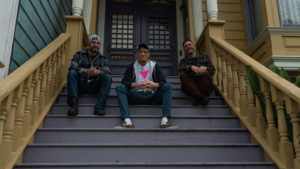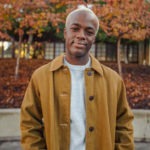Long-term HIV survivors find familial support in unique S.F. group home
This story was originally published in The San Francisco Chronicle on February 21, 2023. Pictured above: A pedestrian passes Marty’s Place, a housing co-op for people living with HIV/AIDS in San Francisco. Stephen Lam/The Chronicle
The yellow Victorian with purple detailing sits behind a gate that opens into a courtyard crowded with patio furniture and a stone fountain of a woman holding a mortar and pestle.
It’s a scene that suggests the idyllic, bright San Francisco imagined in movies and Netflix shows. In fact, it’s a co-op off 25th Street in the Mission District where four men who have HIV and risk homelessness have chosen to live in a supportive community.
Marty’s Place Affordable Housing Corp. is a rarity in a city plagued by sky-high housing costs: a space dedicated to people who are both low-income and HIV-positive. Two of its current residents, Paul Aguilar, 59, and Michael Rouppet, 54, also share something else — they are among the first generation to age beyond the AIDS epidemic, living with HIV as they approach their senior years.
In the living room stands a tall glass case filled with pictures of previous residents — strong-looking men with pets, in parks, smiling brightly. One notable face is Glenn Burke, the first Major League Baseball player to come out as gay. The Oakland athlete, who spent his four-year sports career with the Dodgers and A’s, died in 1995 of complications from AIDS.
When Aguilar tested positive for HIV in 1988 at the age of 25, he was told he might have five years to live. “Something funny happened on the way to my funeral,” he said. “I didn’t die.”
Like thousands of other people with AIDS, Aguilar was given a new lease on life thanks to the introduction of antiretroviral drugs in the 1990s. The medications drive HIV down to undetectable levels, halting the chance of transmitting it to others and allowing people to live longer, healthier lives.
With his reprieve from HIV’s most devastating consequences, Aguilar has had to learn not only to live with the virus, but also to age with it — while lacking the traditional support system of a spouse or children. Losing family to homophobia and friends to AIDS means that many long-term survivors reach old age without such help.
“I know people who have no biological contacts,” Aguilar said. “Their friends are the family they’ve chosen when they got to San Francisco, then AIDS started killing them off.”
According to the National Institute on Aging, nearly half of the 1.2 million people living with HIV in the United States are over 50, as new drugs and better treatment have extended lives and fewer younger people contract HIV due to preventive antiviral treatments. A 2021 report by the San Francisco Department of Public Health found that in San Francisco, nearly three-quarters of those with HIV are age 50 and above.
While most people feel the physical effects of aging, it may happen sooner to those with HIV, even if their viral loads have been rendered undetectable due to medication. Various studies have linked HIV to heart, kidney and cognitive impairments and have found that older people with the virus tend to have more than one chronic condition. Recently published UCLA research also found evidence of accelerated aging at the DNA level in men with the virus. Researchers and physicians are trying to understand why.
Dr. Meredith Greene, an associate professor of geriatrics and an HIV specialist at UCSF, said tobacco, alcohol and substance use may contribute to the phenomenon, and so may the lifesaving medicine that has made such a drastic difference in people’s lives.
“Sometimes it’s also the effects of antiretroviral drugs,” Greene said. “For example, some of the antiretroviral drugs are known to decrease bone mineral density, which can lead to osteoporosis.”
According to Greene, these conditions, and the early onset of them, can become difficult to manage in a health care system that is still learning how to care for older people with HIV.
“Many people I work with at some point were told they were going to die from AIDS, and many of them find themselves 30 years later wondering, ‘OK, I was not prepared for that,’ ” Greene said. “They didn’t plan for retirement. In fact many people quit their jobs or were on disability, so there’s a lot of unique social and economic things happening there.”
Though all current Marty’s Place residents have experienced homelessness or other hardships, the co-op is not officially classified as public or supportive housing. It’s not operated by the government and receives no state funding, nor does it provide case workers or other services offered in some housing situations.
It’s affordable, but not free: The residents pay anywhere from $800 to $1,500 per month, depending on the size of their rooms, and contribute “sweat equity” to housework and management of the co-operative. They’re welcome to apply for outside rent subsidies.
The co-op is a registered nonprofit, overseen by a five-member board that includes both residents and nonresidents. Chores are divided among residents, who agree to run the house democratically and compassionately, noticing when someone isn’t up to the task. It is funded entirely through private donations.
According to Rouppet — a founding member and the longest tenured resident, as well as president of the board of directors — the social housing model frees Marty’s Place from some of the requirements and responsibilities of supportive housing.
There are bylaws and an application process for new members. Marty’s Place can house a maximum of six people — two other men, Jimmy Strahan and Brian Bourassa currently share the space — and residents can stay as long as they’d like. The corporation is currently reviewing applications for the other two spots.
The approach is similar to that of any intentional community: people with common goals, values or experiences — in this case, living with HIV/AIDS — sharing a home. The co-op is open to people of all genders, backgrounds and ages, which, according to Aguilar, adds to its richness.
Marty’s Place was founded in 1993 by Richard Purcell, a Franciscan friar who moved to San Francisco in 1989 to care for his brother, Marty, who was dying of AIDS.
After Marty died, Richard continued to use the house to care for other low-income people who were diagnosed with AIDS. After Richard Purcell died in 2011, the property was transferred to the San Francisco Community Land Trust and Dolores Street Community Services, a San Francisco nonprofit that serves people with HIV/AIDS, many of them long-term survivors.
The phrase “long-term survivor” is primarily used to describe people who contracted HIV before the availability of antiretroviral drugs.
Aguilar, a fourth-generation San Franciscan, became an adult at the advent of HIV/AIDS — the Centers for Disease Control and Prevention’s first report on the virus came out just two weeks before his 18th birthday.
“In August 1981, my first close friend died, and they haven’t stopped dying since,” Aguilar said.
At 30 years old, after realizing he might not die young, Aguilar went to college and met the man who would become his husband until 2011. A decade later, he ended up homeless for two months during the COVID-19 pandemic and applied to be a resident of Marty’s Place, where he moved in 2021.
While San Francisco’s Plus Housing Program helps HIV-positive people with housing subsidies, the program does not provide assistance for those experiencing homelessness, making Marty’s Place a lifeline for some.
The social, almost familial, environment at the house helps address loneliness, another risk factor among older people that can adversely affect their health. According to the CDC, older adults experience loneliness at higher rates because they are more likely to live alone, have a chronic illness or have lost family and friends. These issues are especially prevalent among HIV-positive people.
“On one side of it is people who are rejected by their social networks and ostracized because of their HIV status,” said Mark Brennan-Ing, director of research and evaluation at the Brookdale Center for Healthy Aging at Hunter College in New York. “The other side of it is a perceived stigma and people isolating and withdrawing because they don’t want to deal with the stigma.”
During the recent holiday season, Marty’s Place residents hosted the Harvey Milk Democratic Club’s Holi-gays Party and Meeting.
Dozens of people flooded the home. Snacks and wine bottles covered the countertops while residents filled drinks, made introductions and gave out hugs. Toward the end of the party, Aguilar, wearing a red suit detailed with snowmen, Christmas trees and mistletoe, performed classic Christmas carols as a guest played the piano and sang backup. On Aguilar’s suit was a pin that read “HIV Housing is Health Care.”
“Having a place like Marty’s Place, living with as many as five other guys, you interact with their friends and their friends interact with you and their friends’ friends,” he said. “It becomes a community asset beyond just the residents.”
Aguilar has no plans to leave. “The thought of moving again?” he said. “No, thank you.”

Residents Jimmy Strahan, Paul Aguilar and Michael Rouppet sit on the steps outside of Marty’s Place, a low-income housing co-op in San Francisco for people living with HIV. Jeremiah O. Rhodes
While the four current residents are still able to accomplish day-to-day tasks on their own, they recognize that might not be the case in the coming years.
“There’s a lot of stairs,” Aguilar said. “There’s a lot of stairs to get to the front door, there’s stairs to get to the bedrooms. And now we’re like, ‘Oh, s—!’ because nobody thought about that and we’re getting to that age. So we’re starting to have those conversations now.”
Jeremiah O. Rhodes is a writer with the Investigative Reporting Program at the UC Berkeley Graduate School of Journalism. He reported this story through a grant from The SCAN Foundation.
Reach Jeremiah O. Rhodes: jerorho@berkeley.edu


